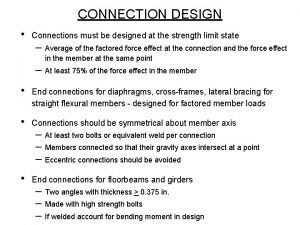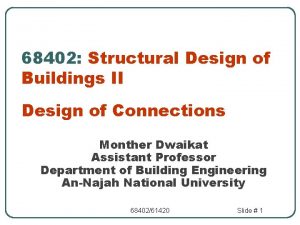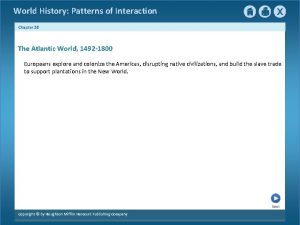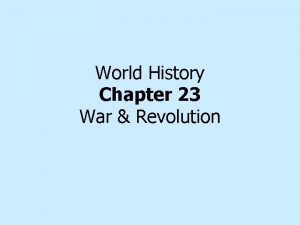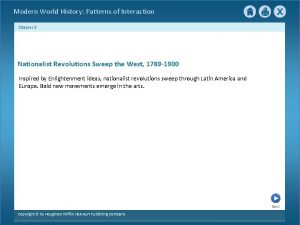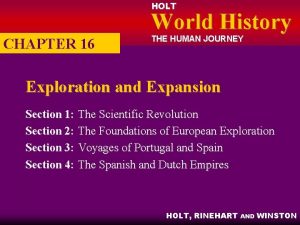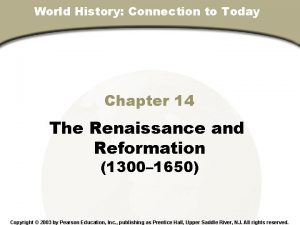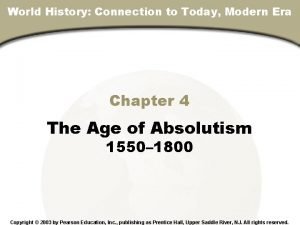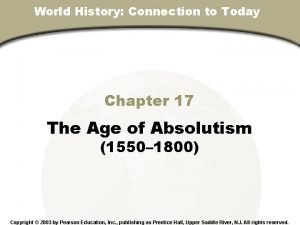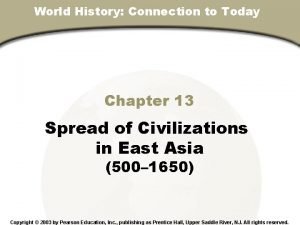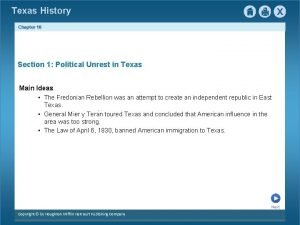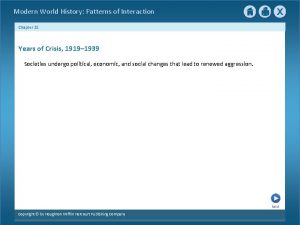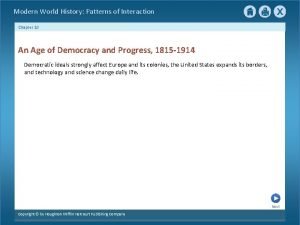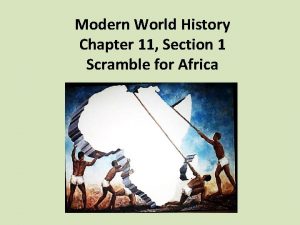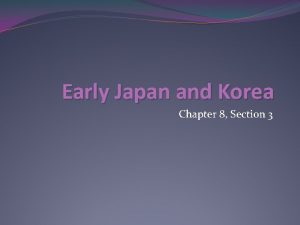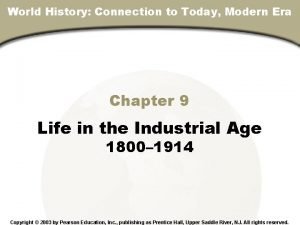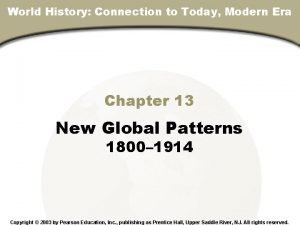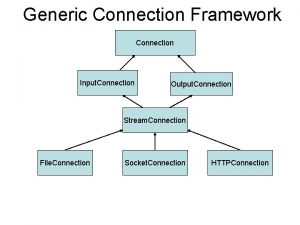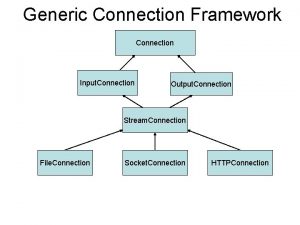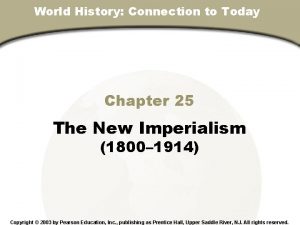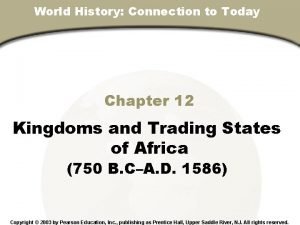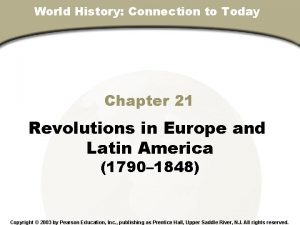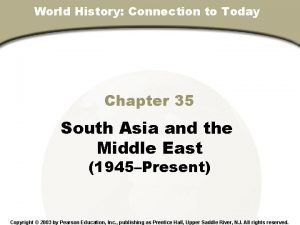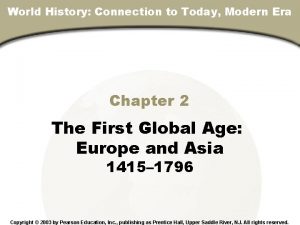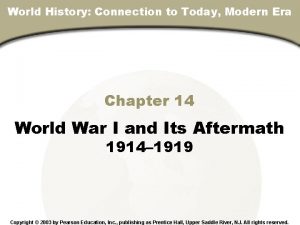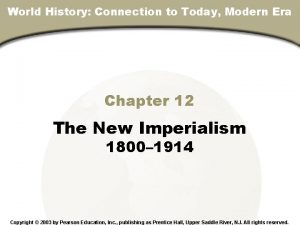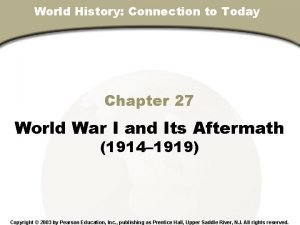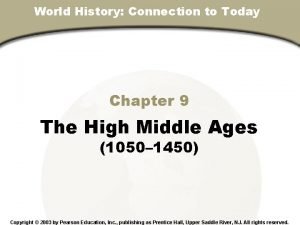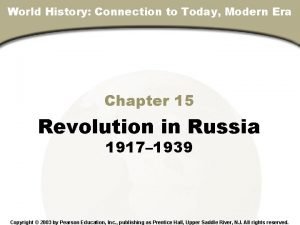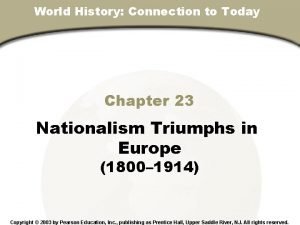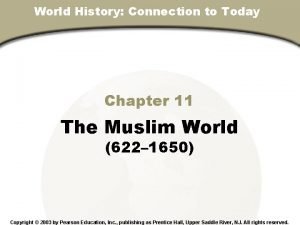World History Connection to Today Chapter 32 Section

























- Slides: 25

World History: Connection to Today Chapter 32, Section Chapter 32 The World Since 1945: An Overview (1945–Present) Copyright © 2003 by Pearson Education, Inc. , publishing as Prentice Hall, Upper Saddle River, NJ. All rights reserved.

World History: Connection to Today Chapter 32, Section Chapter 32: The World Since 1945: An Overview (1945–present) Section 1: The Changing Political Climate Section 2: Global Economic Trends Section 3: Changing Patterns of Life Copyright © 2003 by Pearson Education, Inc. , publishing as Prentice Hall, Upper Saddle River, NJ. All rights reserved.

Chapter 32, Section 1 The Changing Political Climate • How did the end of colonialism and the Cold War shape the world? • How did new nations try to form stable governments? • What role have world organizations played? • What enduring issues face the world today?

Chapter 32, Section 1 The Cold War and the End of Colonialism In the postwar decades, the colonial empires built by the western powers crumbled. In Asia and Africa, people demanded and won freedoms. Between 1950 and 1980, more than 50 new nations emerged in Africa alone. The new nations emerged in a world dominated and divided by the Cold War. Each of the superpowers, the United States and the Soviet Union, wanted new countries to adopt its ideology, or system of thought or belief—either capitalism or socialism.

Chapter 32, Section 1 The Great Liberation and the Cold War, 1945 – 1990

Chapter 32, Section 1 How Did New Nations Seek Stability? After winning independence, new nations had high hopes for the future. Still, they faced immense problems. New nations wrote constitutions modeled on western democracies. Most were unable to sustain democratic rule. As problems multiplied, military or authoritarian leaders often took control. They imposed order by building one-party dictatorships. Despite setbacks, in the 1980 s and 1990 s democracy did make progress in some African, Asian, and Latin American nations.

Chapter 32, Section 1 The Role of World Organizations International organizations deal with issues of global concern. The UN was set up as a forum for settling world disputes. Its responsibilities have expanded greatly since 1945. UN agencies provide services for millions of people worldwide. Many nations formed regional groups to promote trade or meet common needs. Examples include the European Union and the North American Free Trade Association. The World Bank and the International Monetary Fund (IMF) play a large role in the world economy. Other types of nongovernmental organizations have forged valuable global networks. Examples include the International Olympic Committee and the International Red Cross.

Chapter 32, Section 1 Global Issues Many issues pose a challenge to world peace. DEADLY WEAPONS Since the United States exploded two atomic bombs in 1945, nations have poured resources into building nuclear weapons. THE QUESTION OF INTERVENTION HUMAN RIGHTS Human rights include “the right to life, liberty, and security of person. ” Human rights abuses, including torture and arbitrary arrest, occur around the world. TERRORISM Does the world community have a Since the 1960 s, incidents of duty to step in to end human rights terrorism have increased around abuses? How can it intervene when the world. the UN Charter forbids any action that violates the independence of a member nation?

Chapter 32, Section 1 Assessment The Great Liberation refers to the end of a) World War II. b) European colonial empires. c) the Cold War. d) terrorism. Which of the following was a regional group created to promote trade and meet common needs? a) the European Union b) the International Red Cross c) the International Olympic Committee d) the UN Want to connect to the World History link for this section? Click Here.

Chapter 32, Section 1 Assessment The Great Liberation refers to the end of a) World War II. b) European colonial empires. c) the Cold War. d) terrorism. Which of the following was a regional group created to promote trade and meet common needs? a) the European Union b) the International Red Cross c) the International Olympic Committee d) the UN Want to connect to the World History link for this section? Click Here.

Chapter 32, Section 2 Global Economic Trends • In what ways are the global North and South economically interdependent? • Why have developing nations had trouble reaching their goals? • How is economic development linked to the environment?

Chapter 32, Section 2 The Global North and South An economic gulf divides the world into two spheres — the relatively rich nations of the global North and the relatively poor nations of the global South. GLOBAL NORTH It includes the industrial nations of Europe and North America, as well as Japan and Australia. Although pockets of poverty exist, the standard of living is generally high. Most people are literate, earn adequate wages, and have basic health services. Most nations have basically capitalist economies. GLOBAL SOUTH It refers to the developing world. The South has 75 percent of the world’s population and much of its natural resources. While some nations have enjoyed strong growth, overall the global South remains underdeveloped and poor. For most people, life is a daily struggle for survival.

Chapter 32, Section 2 Economic Interdependence Rich and poor nations are linked by many economic ties. • The nations of the global North control much of the world’s capital, trade, and technology. • The global North depends on low-paid workers in developing states to produce manufactured goods as inexpensively as possible. In an interdependent world, events in one country can affect people everywhere. EXAMPLE: In 1973, a political crisis led the oil-rich nations of the Middle East to halt oil exports and raise oil prices. These actions sent economic shock waves around the world.

Chapter 32, Section 2 Obstacles to Development Why have many developing nations been unable to make progress toward modernization? GEOGRAPHY Lack of natural resources, difficult climates, uncertain rainfall, and lack of good farmland have been obstacles for some nations. POPULATION AND POVERTY In the developing world, rapid population growth is linked to poverty. ECONOMIC POLICIES Many new nations saw socialism, rather than capitalism, as a way to modernize quickly. In the long run, socialism blocked economic growth. ECONOMIC DEPENDENCE Most new nations remained dependent on their former colonial rulers. POLITICAL INSTABILITY Political unrest often hindered economic development.

Chapter 32, Section 2 Health Statistics of Selected Countries, 1999

Chapter 32, Section 2 Development and the Environment Economic development has taken a heavy toll on the environment. Modern industry and agriculture have gobbled up natural resources and polluted much of the world’s water, air, and soil. • Strip mining destroyed much land. • Chemical pesticides and fertilizers harmed the soil and water. • Gases from factories produced acid rain. • The emission of gases into the upper atmosphere has caused global warming, the increase in world temperatures. Rich nations consume most of the world’s resources and produce much of its pollution. At the same time, they have led the campaign to protect the environment.

Chapter 32, Section 2 Assessment Which of the following is true? a) The Global South has 75 percent of the world’s population. b) The Global North has 75 percent of the world’s population. c) Most nations in the Global North have basically socialist economies. d) Most people in the Global South enjoy a high standard of living. The country with the lowest infant mortality rate in 1999 was a) Angola. b) Japan. c) the United States. d) Guatemala. Want to connect to the World History link for this section? Click Here.

Chapter 32, Section 2 Assessment Which of the following is true? a) The Global South has 75 percent of the world’s population. b) The Global North has 75 percent of the world’s population. c) Most nations in the Global North have basically socialist economies. d) Most people in the Global South enjoy a high standard of living. The country with the lowest infant mortality rate in 1999 was a) Angola. b) Japan. c) the United States. d) Guatemala. Want to connect to the World History link for this section? Click Here.

Chapter 32, Section 3 Changing Patterns of Life • How are new ways of life replacing old ways? • How has modernization affected the lives of women? • What are the benefits and limits of modern science and technology? • What forces have shaped a new global culture?

Chapter 32, Section 3 How Are New Ways of Life Replacing Old Ways? Urbanization Since 1945, people in the developing world have flocked to the cities to find jobs and escape rural poverty. In the cities, the extended family of rural villages is giving way to the nuclear family. Westernization In cities, people frequently adopt western fashions and ideas. Village Life Westernization and technology are transforming villages. Changes such as roads, clinics, and television can enrich life, but they also weaken traditional cultures.

Chapter 32, Section 3 New Rights and Roles for Women After 1945, women’s movements brought changes to both western and developing nations. • • • By 1950, women had won the right to vote in many countries. A small number of women won elected office. In the industrialized world, more and more women worked outside the home. By the 1970 s, the feminist movement sought greater access for women to jobs and promotions, equal pay for equal work, and an end to sexual harassment on the job. In emerging nations, women worked actively in nationalist struggles. New roles for women raised difficult social issues. Working women had to balance jobs with child rearing and household work.

Chapter 32, Section 3 Science and Technology Since 1945, technology has transformed human life and thought. BENEFITS DRAWBACKS The computer brought an information revolution. Technology has not been able to solve such basic problems as hunger or poverty. Technology has improved life for people everywhere. Technology widened the gap between the global North and South. Medical advances have wiped out some diseases and prevented others. Technology has threatened many kinds of jobs. For example, one computer can process thousands of telephone calls that were once handled by human operators. New technology increased food production for the world’s growing population.

Chapter 32, Section 3 A New Global Culture Modern communication technology has put people everywhere in touch and has helped create a new global culture. • The driving force behind this global culture has been the United States. American fashions, products, and entertainment have captured the world’s imagination. • The western world has also been influenced by nonwestern traditions and culture. • In the last 100 years, the western world has gained a new appreciation for the arts of other civilizations.

Chapter 32, Section 3 Assessment Which of the following was true of women in 1950? a) Many women were elected to public office. b) Women had won the right to vote in many countries. c) The feminist movement had ensured women equal pay for equal work. d) Women were working outside the home while men had taken over traditional household duties. Benefits of the technology age include all of the following except a) increased food production. b) an information revolution. c) the prevention of some diseases. d) an end to hunger and poverty. Want to connect to the World History link for this section? Click Here.

Chapter 32, Section 3 Assessment Which of the following was true of women in 1950? a) Many women were elected to public office. b) Women had won the right to vote in many countries. c) The feminist movement had ensured women equal pay for equal work. d) Women were working outside the home while men had taken over traditional household duties. Benefits of the technology age include all of the following except a) increased food production. b) an information revolution. c) the prevention of some diseases. d) an end to hunger and poverty. Want to connect to the World History link for this section? Click Here.
 Bolted connection
Bolted connection A490n bolts
A490n bolts Minimum fillet weld size
Minimum fillet weld size Connection in literature
Connection in literature Ap world history chapter 25 africa and the atlantic world
Ap world history chapter 25 africa and the atlantic world Chapter 17 section 3 luther leads the reformation
Chapter 17 section 3 luther leads the reformation Chapter 30 section 2 world history
Chapter 30 section 2 world history Chapter 15 section 1 world history
Chapter 15 section 1 world history Chapter 15 section 3 fascism rises in europe
Chapter 15 section 3 fascism rises in europe World history patterns of interaction
World history patterns of interaction World history chapter 8 section 1
World history chapter 8 section 1 Chapter 23 section 3 world history
Chapter 23 section 3 world history Chapter 8 section 1 world history
Chapter 8 section 1 world history Chapter 16 section 1 world history
Chapter 16 section 1 world history Chapter 14 section 1 world history
Chapter 14 section 1 world history Chapter 4 section 4 world history
Chapter 4 section 4 world history Chapter 17 assessment world history
Chapter 17 assessment world history World history chapter 13 section 1
World history chapter 13 section 1 World history chapter 10 section 1
World history chapter 10 section 1 Chapter 15 section 2 world history
Chapter 15 section 2 world history Chapter 10 section 1 world history
Chapter 10 section 1 world history World history chapter 11 section 1
World history chapter 11 section 1 Chapter 8 section 3 world history
Chapter 8 section 3 world history Chapter 9 section 2 world history
Chapter 9 section 2 world history Chapter 6 section 2 world history
Chapter 6 section 2 world history Chapter 13 section 2 world history
Chapter 13 section 2 world history
